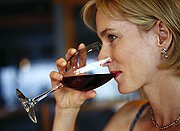Bar Drinks Pack More Punch Than Thought
Glasses of wine, beer and spirits bigger than the standard, study finds.
By Randy Dotinga
HealthDay Reporter
|
E-mail this article
Subscribe to news
Printer friendly version
|

(SOURCES: William C. Kerr, Ph.D., senior scientist, Public Health Institute's Alcohol Research Group, Emeryville, Calif.; Dwight Heath, Ph.D., professor of anthropology, Brown University, Providence, R.I., September 2008, Alcoholism: Clinical and Experimental Research)
WEDNESDAY, June 18 (HealthDay News) -- If you sidle up to a bar and assume one drink an hour won't make you legally drunk, think again. A new study finds that bartenders pack a lot more booze into common drinks than many people realize.
Researchers visited 80 bars and restaurants in Northern California last year and found that glasses of wine and spirits are often 50 percent larger than the "standard" size used in guidelines. That means people who follow recommendations about avoiding more than one drink an hour may be getting more booze than they bargained for, the study found.
"These things can creep up on someone without their being aware," said study lead author William Kerr, a senior scientist at the Public Health Institute's Alcohol Research Group. "There should be caution."
Kerr and his colleagues launched their study as part of ongoing research into alcohol consumption. "It occurred to me that we didn't know much about what people meant when they said they had a drink," he said.
The researchers visited 80 randomly selected drinking establishments in Northern California, including some in the major cities of San Francisco, Oakland and Sacramento. Some were bars, while others were restaurants.
The researchers typically visited in groups of three to four and bought a round of drinks. Then one member of the group would use a cylinder to measure the drinks. Sometimes the researchers would duck into the restroom so they wouldn't be noticed. Bartenders occasionally noticed what the researchers were doing and spoke up, but they never made a major fuss, Kerr said.
An analysis of 480 drinks found that wine, beer and mixed drinks were often 50 percent larger than a "standard" drink. The average glasses of wine and mixed drinks were 42 percent to 43 percent larger, and the average draft beer was 22 percent larger. (Bottled beers weren't measured.)
Glasses of wine, meanwhile, typically packed more alcohol per volume -- 14 percent instead of 12 percent -- than those used to define a standard drink.
Factors like the type of establishment, the region of Northern California and the gender of the bartender didn't seem to affect the sizes of the drinks, Kerr said.
The findings were expected to be published in the September issue of Alcoholism: Clinical and Experimental Research and are available online.
Some people use the definition of a standard drink to figure out how much they can drink before becoming drunk.
"If the chart says you can have five standard drinks (before you get drunk), you can only have three to four of these actual drinks," Kerr said.
Dwight Heath, a professor of anthropology at Brown University who studies alcohol consumption, said the study "points out a dirty little secret of alcohol research: The definition of 'standard drink' is inaccurate and out-of-date."
Researchers have failed to recognize and adjust to "changes in culture," Heath said.
More information
Learn more about alcohol and potential health risks at Pace University. 
Copyright © 2008 ScoutNews, LLC. All rights reserved. 
HealthDayNews articles are derived from various sources and do not reflect federal policy. healthfinder.gov does not endorse opinions, products, or services that may appear in news stories. For more information on health topics in the news, visit the healthfinder.gov health library.